Before we show you Felix’s solution, let’s remind ourselves of the challenge he was posed.
The Premier League has finally decided to listen to @RomeluLukaku9’s request to play a North vs South All-Star match. The FA appointed Brendan Rodgers as the coach for Team North.
*Please read the disclaimer at the bottom of the tread before being upset about our N/S divide.
— Total Football Analysis (@TotalAnalysis) April 6, 2020
Lineup – 3-4-1-2
Kepa (Chelsea); T. Alderweireld (Tottenham Hotspur), L. Dunk (Brighton and Hove Albion), N. Aké (Bournemouth); H. Bellerín (Arsenal), D. Rice (West Ham), A. Doucouré (Watford), M. Aarons (Norwich City); W. Zaha (Crystal Palace); D. Ings (Southampton), P. E. Aubameyang (Arsenal)
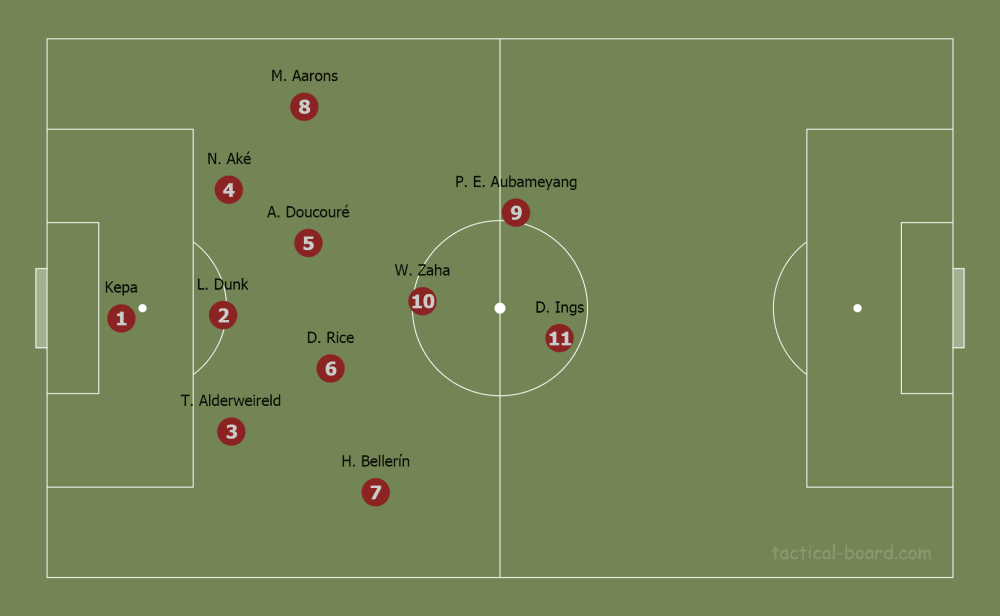
General plan
I expect the opposition to try to dominate the game and use when they are out of possession an aggressive and high (counter-)pressing. The two reasons for that are the current Leicester City manager, Brendan Rodgers, is one who favours this philosophy and additionally has the players with the qualities to dominate the match.
Because of that, we will try to eliminate their strengths in every phase of the game as much as this is possible and additionally look (where possible) to exploit their very few weaknesses. We will concede the majority of possession but want to avoid them getting it in situations which they favour. Next, we’ll look through our tactics in the four phases of the match.
Opposition’s possession
Within the opening phase of this match (first 10 minutes), we’ll execute a high pressing and counter-pressing tactic. While the counter-pressing is man-orientated, the high pressing in the opening 10 minutes will be a certain pattern.
As Rodgers’ left side with Van Dijk, Digne and De Bruyne is clearly better when it comes to the ball-playing abilities of the players, we want to force them on their right side. Besides, I expect De Bruyne to drop deeper during the build-up at about the line Ndidi holds what is common for Rodgers’ teams. De Bruyne is among the very best playmakers of the EPL while Ndidi has his strengths defensively. Wan-Bissaka and Tarkowski are not weak on the ball but clearly not as good as Van Dijk and Digne. Due to that, when we press in the opening 10 minutes, we want to force them on their right side and put pressure on Wan-Bissaka. For that, Ings will man-mark Van Dijk whenever the goalkeeper has the ball while Aubameyang leaves Tarkowski free to provoke the pass to him. As soon as this ball is played, our left striker uses a curved run to force Tarkowski to play the ball to his right-back (or a long ball which we win). As soon as the ball is played to Wan-Bissaka, Aarons will press in at him and either wins the ball or forces his opponent to a long ball. Throughout the whole sequence, our three central midfielders man-mark Ndidi, KDB and Fernandes. Arsenal‘s Bellerín is close to Digne while the three strikers are also man-marked. Considering this, we play man-to-man over the whole pitch except Aubameyang and Aarons who stay slightly away from their opponents to provoke the passes as we can see below.
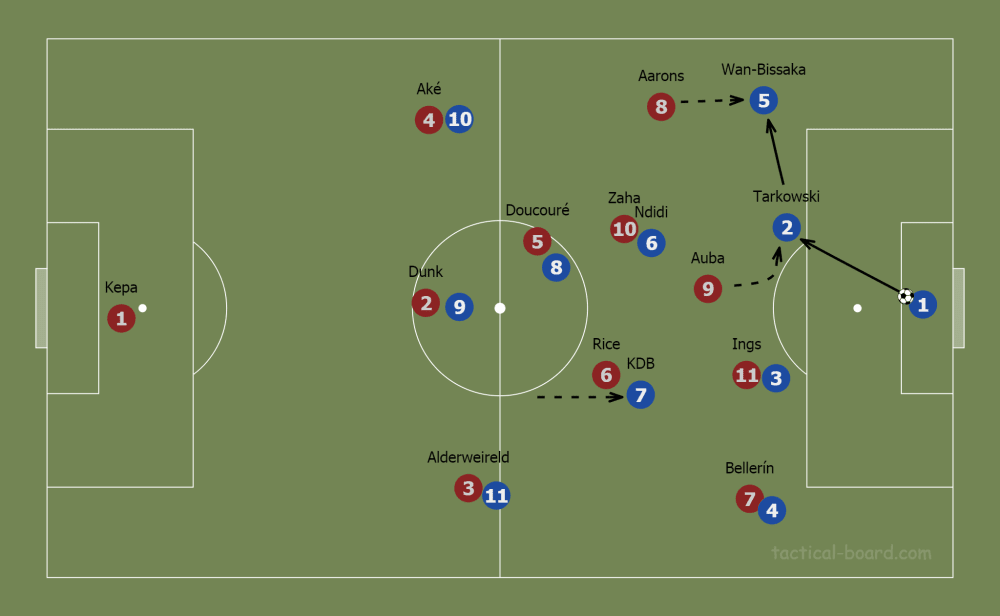
One important point for Aké in these situations is that he should always be ready for the long balls behind him as the pace of Traore will likely be their favoured way out of this situation.
After the opening phase, we will drop back deeper in a 5-2-1-2 formation which switches to a 5-3-2 or a 5-2-3 depending on Zaha’s positioning which will depend on Ndidi which he follows. I decided to neither go with a full man-marking when we drop deep nor just defend the space as we will use a mixture of both.
When we defend deeper, Aubameyang and Ings attack the opposition at the height of the halfway line. Since Rodgers likes to use asymmetric movements during build-up and use a 2-3-5 or 3-2-5 formation, we will also react “asymmetrically”. However, not with our formation, but the tasks of the players.
Both full-backs will support their wingers and push forward while Fernandes is the more offensive orientated man compared to KDB who will stay a bit deeper with Ndidi, the centre-backs and one full-back. Whenever one full-back pushes forward, the other one will stay deeper. As KDB is the more defensive central midfielder and Wan-Bissaka is more offensive orientated compared to Digne, we expect them especially attack down the right-wing. This is also the reason why Aarons will be more defensive orientated along with Doucouré (who is defensively stronger compared to Rice) to be more defensive.
Our basic defensive structure can be seen in the shot below.
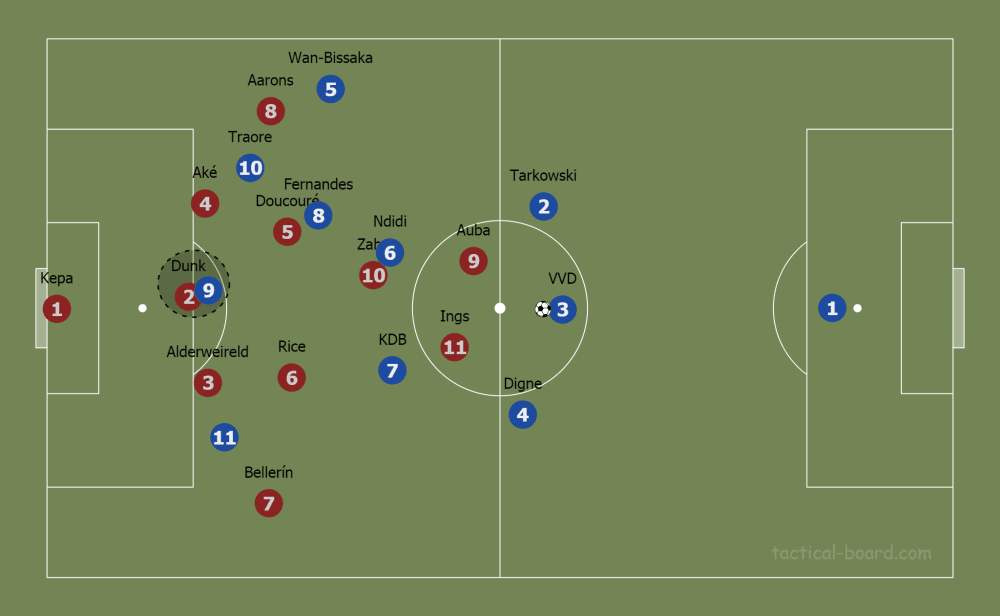
Dunk will stay close to Moussett and that gives us a 3v3 on our left side when the ball is in the centre. Zaha stays near Ndidi while Ings cuts off the passing lane towards KDB.
As soon as the ball is played forward on their right side, Dunk will shift over to create numerical superiority while Moussett is then marked by Alderweireld and Bellerín looks after Grealish. Zaha is still near Ndidi while Rice should occupy the central space in front of the penalty box and have an eye on KDB.
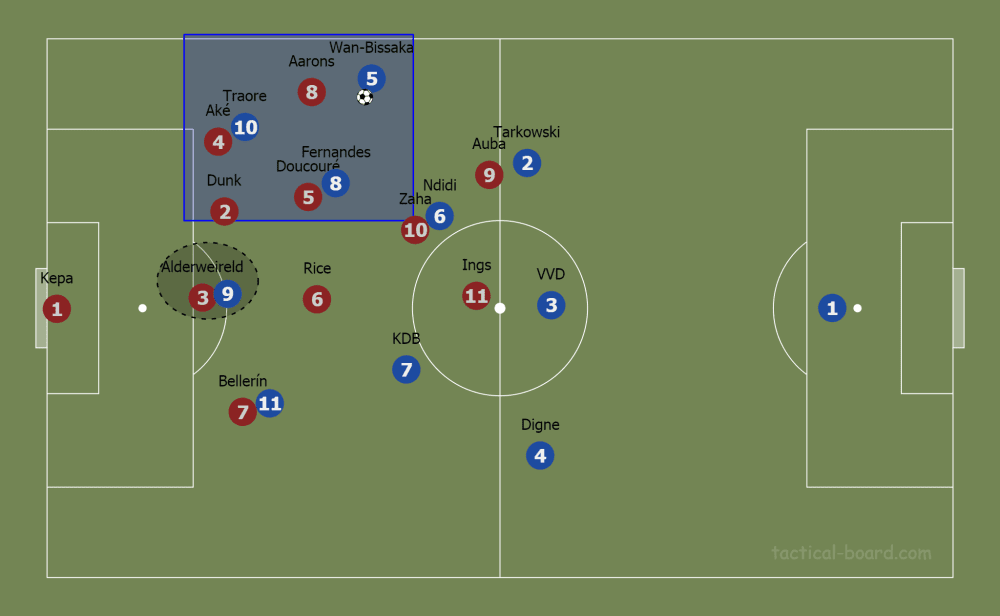
With the aforementioned “asymmetric” tasks of my players, I meant that the men on our left side need to permanently look out for the through ball behind our last line as Wan-Bissaka and Traore are faster than Digne and Grealish who are stronger when they have the ball at their feet.
When the ball is played on the left side of Rodgers’ squad, the pattern of how we shift over is the same as Dunk leaves the centre to create again a numerical superiority while Aké marks Moussett. Also, Doucouré is now in the space in front of the penalty box and tracks Fernandes’ movements. Meanwhile, our men on the right side should work together to avoid 1vs1 situations which can be deadly against Grealish or Digne. This is also the reason why we have on the left side the fast Aké and Aarons while on the right side we have the more experienced and defensive strong Alderweireld and Bellerín.
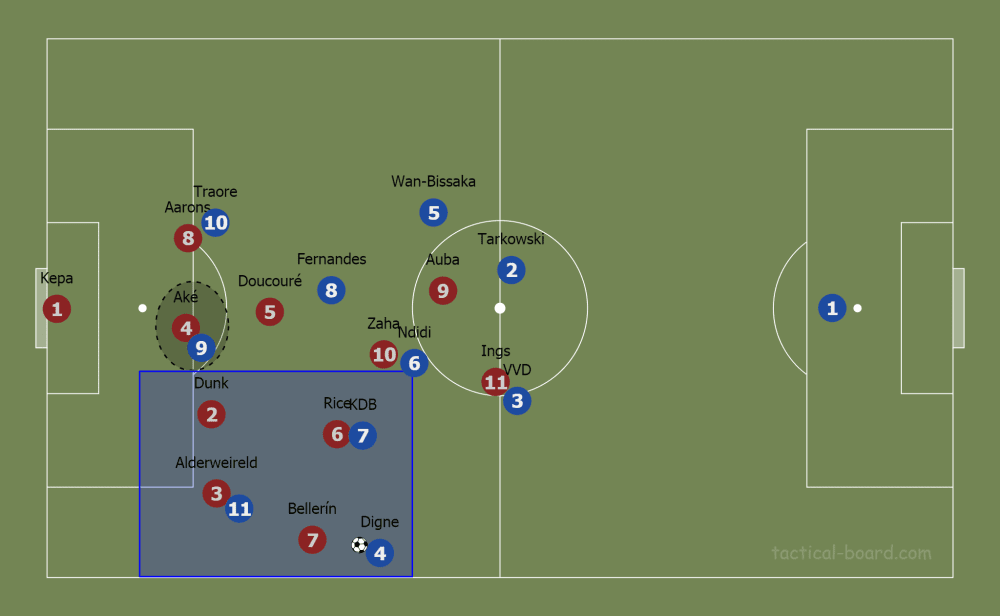
Offensive transition
The fact that we defend so deep has two reasons. Firstly, the opposition have so much quality that the risk that they bypass our press regularly is too high. Secondly, Rodger’s teams always play with a high defensive line when they are in possession what means that we want to hurt them on the break, and we have the perfect players for that.
Since the opposition will mainly attack down the wings, we also plan our counter-attacks to often start from there. In these situations, there are two spaces in which we want to come. The first one is behind the defensive line (in the shot below red) as when we get there, we can easily create something dangerous with Aubameyang, Ings and Zaha. The second area is the one in front of the defensive line (in the image below white) as it must be a goal to get Zaha in this space with the ball at his feet.
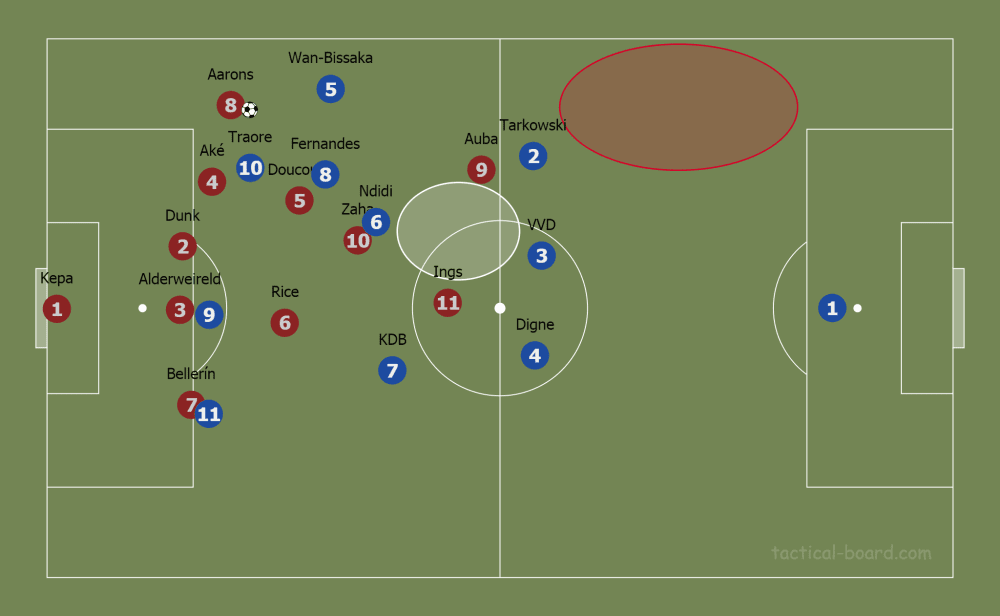
As the distance for a diagonal long ball (when our LWB wins the ball and wants to find our right striker with a through ball or the other way around) is too long, we focus on long balls down the line when we want to reach the “red” zone. Logically, in these moments the strikers also need to start their runs early to pick up enough speed.
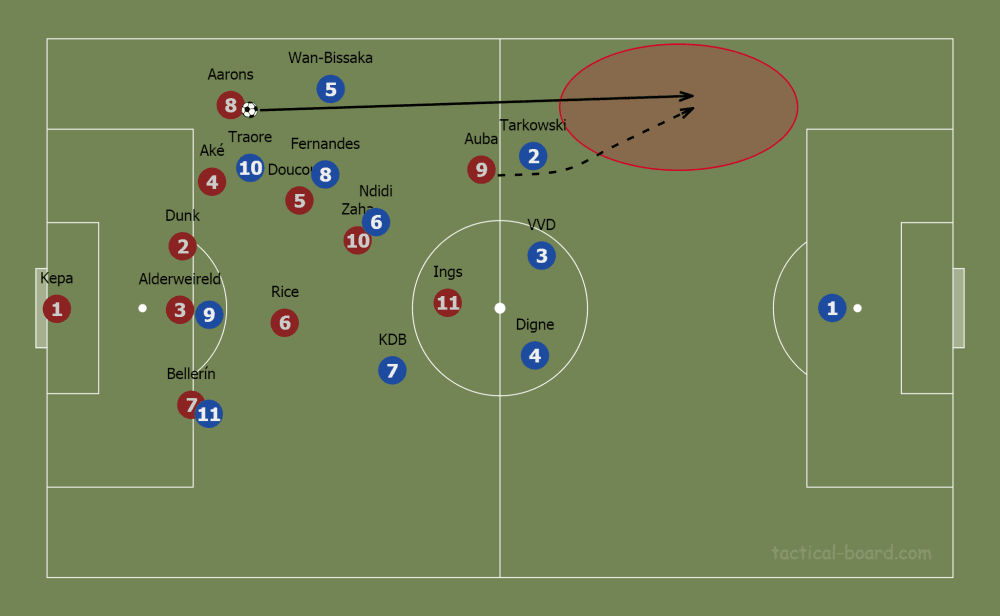
The way to get Zaha with the ball at his feet in the “white” zone, is a bit more complicated as we want to avoid passes which Ndidi could intercept and also avoid Zaha getting into a 1vs1 with him since he’s incredible in both defensive disciplines. Due to that, we try to find the striker on the according side with a long ball who then should lay off the ball for Zaha who gets away in the back of Ndidi
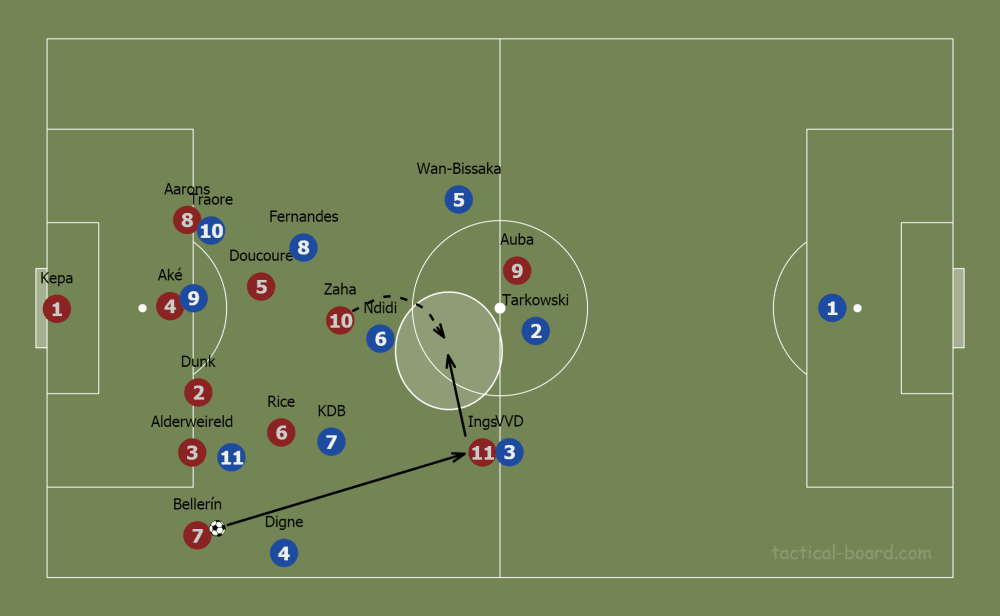
Whenever we win back the ball in the centre, it’s hard to get into the “white” space in front of the opposition’s centre-backs. Due to that, the central players should try to play diagonal balls into the “red” spaces whenever they win back the ball. It’s also logical that whenever we win the ball back on the left side, we tend to play the long ball down the line as we have Aubameyang on this side while on the right side we have Ings who won’t always beat Van Dijk to the ball. Due to that, we will predominantly play a long ball towards Ings which he should lay off for Zaha
Own possession
Since we expect that Rodgers’ team use a high pressing whenever we have the ball, we want to overcome it with long balls. However, these long balls shouldn’t be through passes behind the last line of the opposing defence, but we want to win the second balls in the area in front of the defence. Since Van Dijk is a monster in the air, we tend to play the long balls towards one of the other three players of the opposing back four. The main target should be the duo of Aubamyang as Tarkowski since in this duel we have the best chance to win the aerial duel.
However, the main goal isn’t to win the duel in the air itself as I want all surrounding players position in the space in front of the defence around the players who are in the duel to win the second ball and overcome the press. In the shot below we can see how it should work when we play the long ball towards Aubameyang.
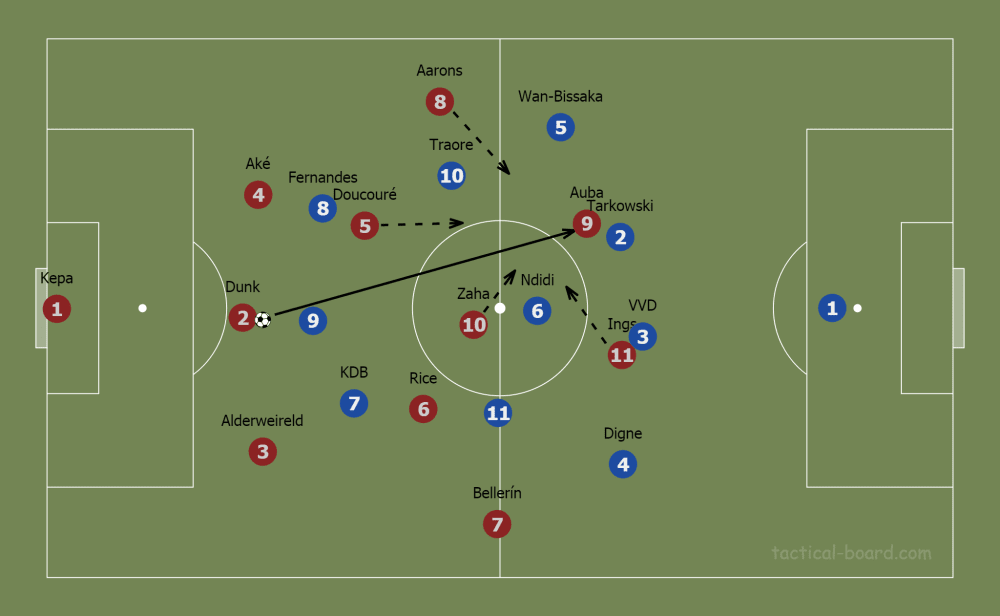
So, in this situation, Ings, the according wing-back, Zaha and the according defensive midfielder should position near Aubameyang to have a good chance to win the second ball.
Now, when we are able to have possession in the final third, we want to attack down the wings and swing in crosses in as we have two strikers upfront together with Zaha what means that we enough bodies in the box what means that we have quite good chances to get on the ball.
There are two options of how we want to attack down the flanks. Either we try to get our wing-backs into a 1vs1 situation with the opposing full-backs or we try to find them with through passes behind the last line of Rodgers’ defence (what will be our preferred option).
However, as we already saw when we tried to find a way how to progress the ball further up the pitch, neither of our strikers is really stronger than his direct opponent in the air and especially Zaha won’t win anything in the air against Ndidi. Due to that, we will mainly work with low balls into the box.
As the forwards should know how the ball will be delivered, the wing-backs have the task to either play a strong powerful delivery in the box (in the space between goalkeeper and defenders) or a simple ball in the back of the defenders where mainly Zaha or one of the two defensive midfielders should be positioned (the DM of the according site over which we attack is allowed to go forward while the other one stays deeper to have some protection).
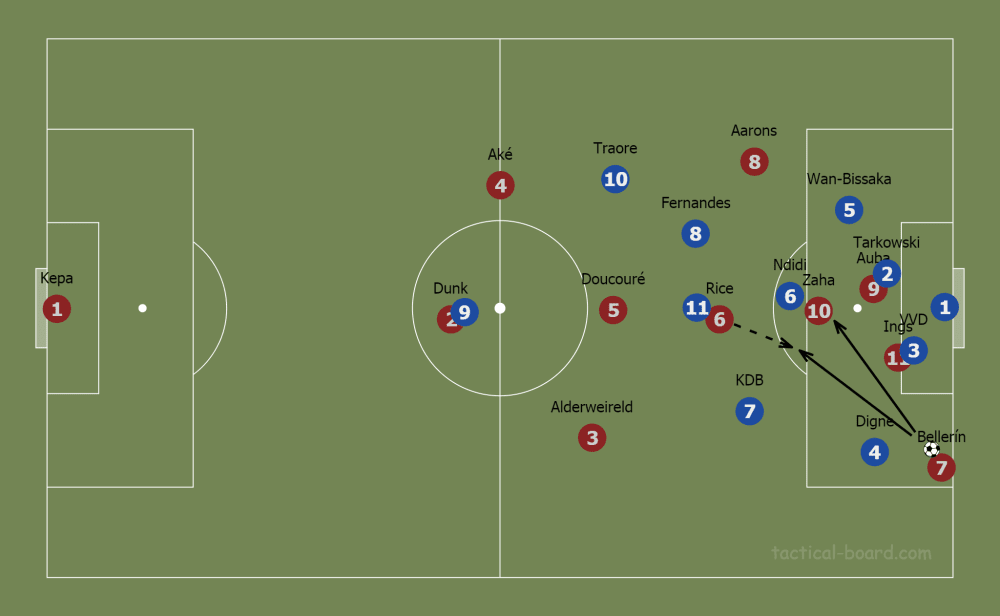
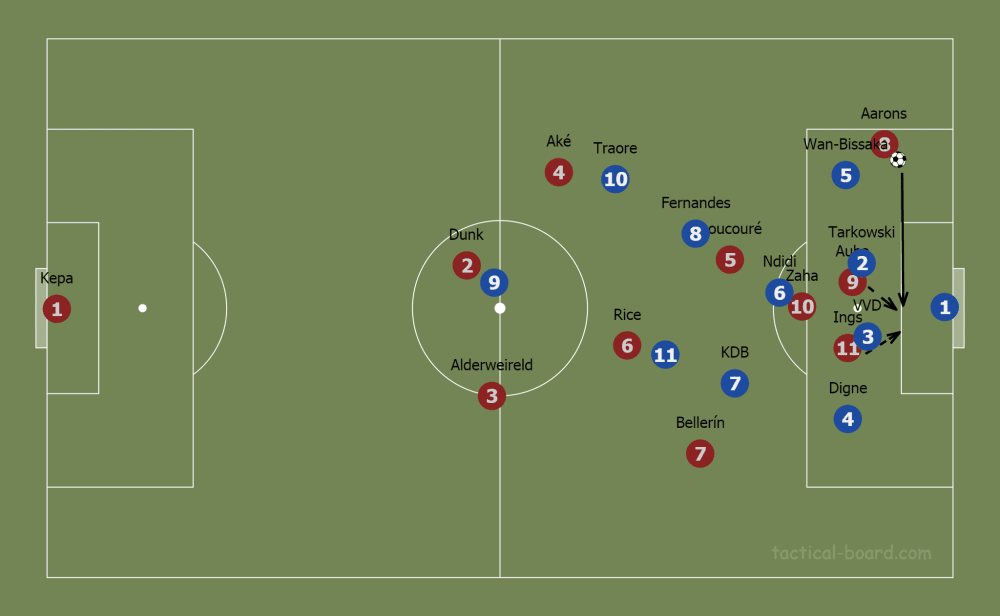
As the last point, I need to mention that basically, we stay in our 5-2-1-2 formation which turns into a 3-4-1-2 when we have the ball due to the higher positioning of the wing-backs. As already mentioned, one defensive midfielder is allowed to go forward while the other one stays deeper. Meanwhile, both wing-backs can push forward, but the only player who has the freedom to move quite freely is Zaha as we want to see how Ndidi reacts to this. Will he follow him or will he stay in his space and tell someone else to mark him?
The reason why we stay in our formation without that much rotation or positional changes is that we need to be able to get as quick as possible in our defensive shape. Also, in the moments in which Rodger’s side sit back deeper in their 4-3-2-1 formation as the wingers drop on the height of Ndidi and the CMs position behind Moussett, we try to build up our attacks with short passes and again get dangerous over the flanks. This means that we don’t only play the long balls when they sit back deeper but use long balls (and win the second ball) and short passes what gives us more variability.
Defensive transition
As already mentioned, we will use in the opening 10 minutes a man orientated counter-pressing as soon as we lose the ball. This should help us in the opening phase to show them that we are ready to compete with them.
After this opening phase, we will drop deeper whenever we lose the ball except, we have a clear numerical advantage around the ball. However, even in these moments, we set for ourselves a time limit of 5 seconds. When we don’t get the ball back in this time frame, we will drop deeper and use the defensive tactics which I already described.
Conclusion
All in all, it will be hard to be successful against a team of such incredible individuals as we saw in this tactical analysis. However, our defenders should be aware of the fact that their players on the right side are ones who more use their pace while Grealish and Digne are incredibly strong on the ball. With our detailed plan for the counter-attacks and how we want to get dangerous in the final third (as described above in this analysis), we will surely be able to hurt them.





Comments